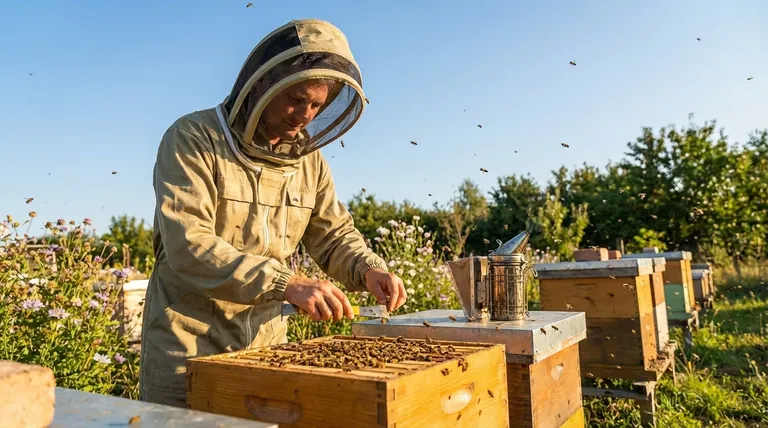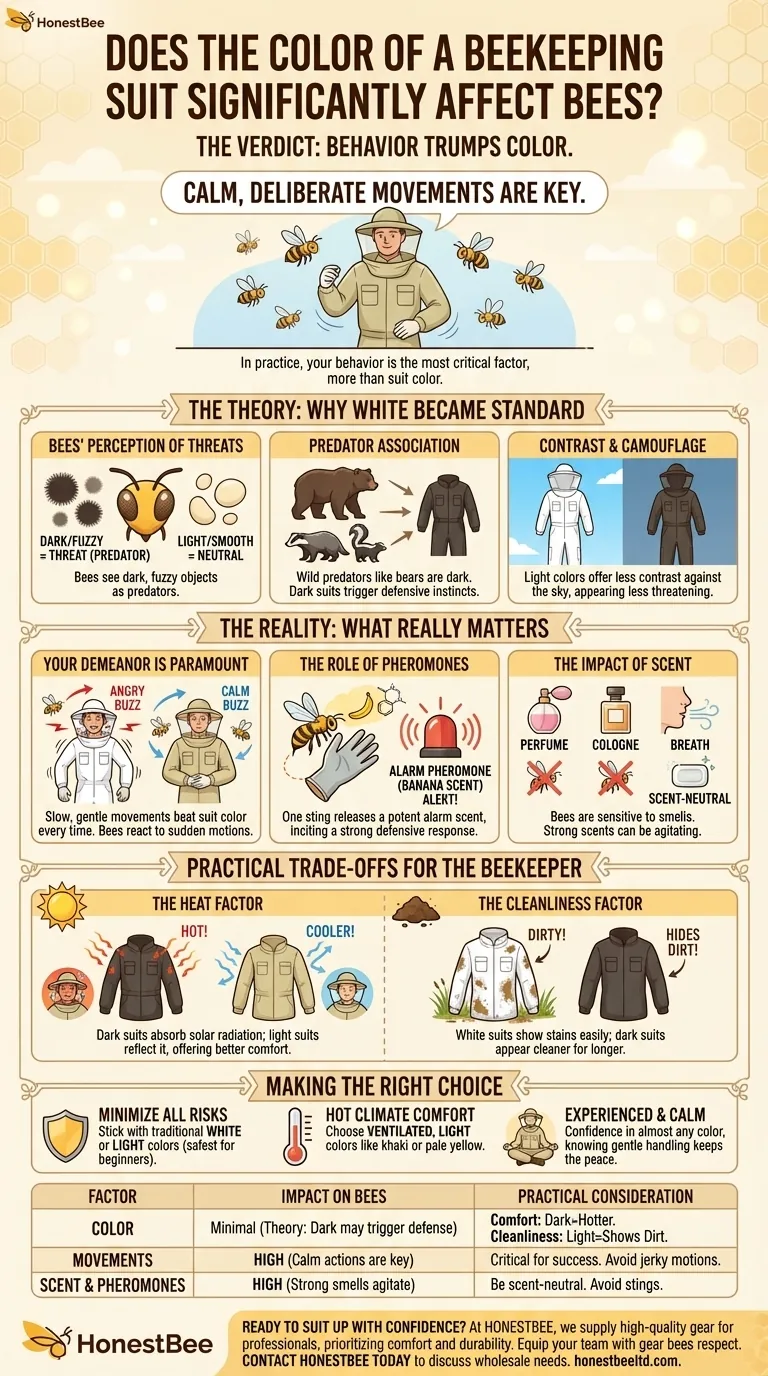In practice, the color of your beekeeping suit is not the most critical factor in bee behavior. While traditional wisdom strongly favors white, many experienced beekeepers use other light colors without any noticeable difference in the bees' temperament. The primary concerns with color relate more to the beekeeper's comfort and the visibility of dirt than to provoking a defensive response from the hive.
The core principle to understand is that a beekeeper's calm, deliberate movements have a far greater impact on hive temperament than the specific color of their suit. While bees are theoretically more agitated by dark colors that mimic natural predators, your behavior is the deciding factor in a peaceful inspection.

The Theory: Why White Became the Standard
For decades, beekeeping manuals have insisted on white suits. This recommendation isn't arbitrary; it's based on an understanding of bee biology and instinct.
How Bees Perceive Threats
Bees do not see the world as we do. Their vision is tuned to identify flowers and threats. Dark colors, especially when combined with a fuzzy texture, can be perceived as a large, dark void or, more importantly, a natural predator.
The Predator Association
The primary predators of honeybee colonies in the wild are animals like bears, badgers, and skunks. These animals are typically dark and furry. A dark beekeeping suit can trigger a bee's instinctual defensive reaction, prompting them to attack what they perceive as a threat to their colony's survival.
Contrast and Camouflage
A white or light-colored suit provides less contrast against a bright sky. This makes the beekeeper appear as a less defined, less imposing, and less threatening figure from the bees' perspective as they fly around the apiary.
The Reality: Why Behavior Trumps Color
While the theory is sound, practical experience shows that other factors are much more significant in determining how bees will react during a hive inspection.
Your Demeanor is Key
Slow, gentle, and deliberate movements are paramount. A calm beekeeper in a khaki suit will have a much better experience than a nervous, jerky beekeeper in a pristine white one. Bees react to sudden movements and vibrations far more than they do to static colors.
The Role of Pheromones
When a bee stings, it releases an alarm pheromone that smells faintly of bananas. This chemical signal instantly alerts other bees to a threat, inciting a much stronger defensive response than color ever could. Avoiding the first sting is critical.
The Impact of Scent
Bees are also highly sensitive to smells. Strong perfumes, colognes, or even the scent on your breath can be agitating to a colony. It's always best to be as scent-neutral as possible when working with your hives.
Understanding the Practical Trade-offs
When choosing a suit, the color's impact on you, the beekeeper, is often more important than its impact on the bees.
The Heat Factor
This is the most significant practical difference. A dark-colored suit will absorb much more solar radiation, making it considerably hotter on a sunny day. Given the physical nature of beekeeping, maintaining comfort and avoiding overheating is a serious safety consideration.
The Cleanliness Factor
White and light-colored suits show dirt, mud, grass stains, and especially propolis very easily. Darker suits have the clear advantage of looking cleaner for longer, which can be a consideration for beekeepers who value tidiness or teach classes.
Making the Right Choice for Your Goal
Your choice of suit color should be based on your experience level, the temperament of your bees, and your personal comfort.
- If your primary focus is minimizing all potential risks: Stick with a traditional white or very light-colored suit. This is the safest bet, especially for new beekeepers or those working with more defensive colonies.
- If your primary focus is personal comfort in a hot climate: A ventilated suit in a light color like khaki or pale yellow is an excellent choice, balancing heat reflection with practicality.
- If you are an experienced beekeeper with calm colonies: You can confidently wear almost any color you prefer, knowing that your gentle handling techniques are what truly keep the peace.
Ultimately, your calm confidence and gentle movements are the most effective tools you have for a peaceful apiary.
Summary Table:
| Factor | Impact on Bees | Practical Consideration for Beekeeper |
|---|---|---|
| Color | Minimal (theory suggests dark colors may trigger defense) | Comfort: Dark suits are hotter. Cleanliness: Light suits show dirt easily. |
| Beekeeper's Movements | High: Calm, deliberate actions are key to a peaceful inspection. | The most critical factor for success. Avoid sudden, jerky motions. |
| Scent & Pheromones | High: Strong smells and alarm pheromones can agitate bees. | Be scent-neutral. Avoid perfumes and try to prevent the first sting. |
Ready to Suit Up with Confidence?
Whether you're a commercial apiary or a distributor, having the right gear is the foundation of safe and productive beekeeping. At HONESTBEE, we supply high-quality beekeeping suits and equipment designed for professionals who understand that comfort and durability matter just as much as theory.
Let us help you equip your team with gear that supports the calm, confident demeanor bees respect.
Contact HONESTBEE today to discuss your wholesale needs and find the perfect protective solutions for your operation.
Visual Guide

Related Products
- Cotton Beekeeping Suit and Round Hat with Veil Bee Keeper Protective Gear
- Professional Beekeeping Suit for Kids and Girls Childrens Bee Keeper Suit
- White Beekeeping Protective Suit and Hat with Fencing Veil for Beekeepers
- Beekeeper Cowboy Hat and Veil for Beekeeping
- Heavy Duty Cowboy Beekeeper Hat with Visibility Veil Outdoor Professional Beekeeping Protective Gear
People Also Ask
- How should a beekeeping suit be hung to maintain its shape? Protect Your Investment with Proper Storage
- What should be considered regarding the color of beekeeping clothing? Ensure Your Safety and Keep Bees Calm
- What is recommended for beginners in beekeeping regarding protective clothing? A Complete Safety Guide for New Beekeepers
- What factors should be considered when choosing a beekeeping suit? Balance Safety, Comfort & Performance
- What are the benefits of a fully ventilated beekeeping suit? Stay Cool and Protected in Hot Climates



















